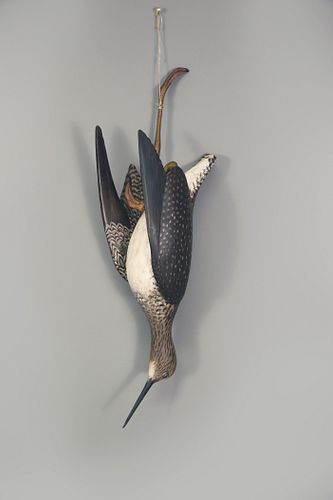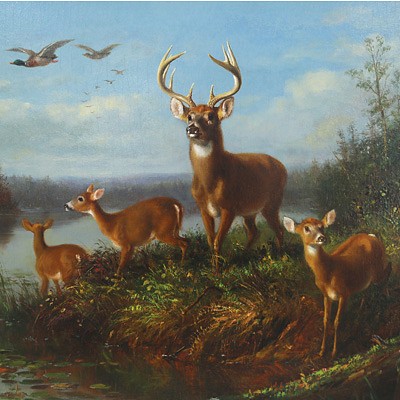The du Mont Early Hanging Greater Yellowlegs by A. Elmer Crowell (1862-1952)
Lot 25
About Seller
Copley Fine Art Auctions
20 Winter Street
Pembroke, MA 02359
United States
Founded in 2005, Copley Fine Art Auctions is a boutique auction house specializing in antique decoys and American, sporting, and wildlife paintings. Over the course of the last two decades, the firm has set auction records for not only individual decoy makers, but also entire carving regions. Copley...Read more
Estimate:
$20,000 - $30,000
Absentee vs Live bid
Two ways to bid:
- Leave a max absentee bid and the platform will bid on your behalf up to your maximum bid during the live auction.
- Bid live during the auction and your bids will be submitted real-time to the auctioneer.
Bid Increments
| Price | Bid Increment |
|---|---|
| $0 | $50 |
| $1,000 | $100 |
| $2,500 | $250 |
| $5,000 | $500 |
| $10,000 | $1,000 |
| $25,000 | $2,500 |
| $50,000 | $5,000 |
About Auction
By Copley Fine Art Auctions
Feb 24, 2023
Set Reminder
2023-02-24 10:00:00
2023-02-24 10:00:00
America/New_York
Bidsquare
Bidsquare : The Winter Sale 2023, Day 1
https://www.bidsquare.com/auctions/copley/the-winter-sale-2023-day-1-11939
Lots 1-337 Copley Fine Art Auctions cinnie@copleyart.com
Lots 1-337 Copley Fine Art Auctions cinnie@copleyart.com
- Lot Description
The du Mont Early Hanging Greater Yellowlegs
A. Elmer Crowell (1862-1952)
East Harwich, MA, c. 1915
16 3/4 in. long
"Seldom does one find special orders made by Crowell and when you do they tend to be the best. These were usually done for gunning friends. The [du Mont] hanging greater yellowlegs is a prime example of what lengths Crowell would go to for special customers. It is a life size bird with two applied wings and wonderful dry brushed paint and tack eyes. It was made to hang by the legs to simulate a recent bag from a hunt. It is a particularly early carving with tack eyes and the best 'folky' look one could ask for in a Crowell." - Brian Cullity, author and curator of "The Songless Aviary, The World of A.E. Crowell and Son"discussing this exact carving
"When I was shooting for market on shore birds, the yellowlegs (lesser and greater) were the most plentiful. I made many good bags, with a few Jack Curlews and other shore birds." - A. Elmer Crowell, "Cape Cod Memories"in "Duck Shooting Along the Atlantic Tidewater"
Much of Elmer Crowell's portfolio references his origins as a young market hunter, but few works do so as directly as this early and elaborate hanging game carving. Incredibly, the young hunter built his first gunning stand in 1876 in order to harvest birds for sale, shipping his quarry by rail to Boston's famous Faneuil Hall marketplace.
This rare, if not unique, carving from the esteemed du Mont Collection is among the most nuanced carvings that Crowell ever attempted, with applied raised wings, a curved tail, and detailed wooden legs. Each wing received significant carving detail, with scalloped edges, delineated feather groups, and incised secondary feathers. As seen with his more common flying birds and wing-up preeners, the painter showcases his knowledge and ability on every inch of the expanded surfaces. The feather blending throughout is especially fine with the head and interiors of the wings exhibiting notable care.
This carving hails from the distinguished collection of John Sanderson du Mont, a third generation friend and patron of Crowell's. Du Mont's great aunt and uncle were Roland C. (1859-1906) and Addie D. Nickerson (1859-1955) and John's father was Horatio S. du Mont (1886-1970). In a 1987 article introduced by Alan Haid, the younger du Mont recalled, "My father, either at my request or when doing errands, would drop me at Crowell's where I would sit quietly and watch him carve and paint. He never objected."He also recounts, "Recognizing Crowell's ability, my father assembled a collection of 21 shorebird and duck heads, some miniatures, and a series of life-size bird carvings. Mother's diary indicates that most of these were collected by 1917." This carving dates to that early period and may have come down to John from his father and shorebird hunting companion.
Regarding related works, there are few known to have survived in any condition. One later lesser yellowlegs is in the collection of the Shelburne Museum, and another is in private hands. One hanging bobwhite quail is in the Paul Tudor Jones II Collection and is illustrated in "Elmer Crowell: Father of American Bird Carving."
Excellent overall condition, original paint with light wear including craquelure to breast. Restoration to 2 1/2 inches of primary feathers of left wing tip, to right corner of tail, and toes of left leg. Right leg is reset.
Provenance: John S. du Mont Collection
Private Collection, Cape Cod
Literature: Stephen B. O'Brien Jr. and Chelsie W. Olney, "Elmer Crowell: Father of American Bird Carving," Hingham, MA, 2019, p. 42, hanging quail carving and related Harry V. Long journal entry illustrated. A. E. Crowell and Eugene V. Connett, ed., "Duck Shooting Along the Atlantic Tidewater," "Cape Cod Memories,"New York, NY, 1947, pp. 56-57, early market hunting discussed by Crowell. Northeast Auctions, "The John S. du Mont Collection," Portsmouth, NH, August 19, 2007, p. 13, Brian Cullity quote and lot 709, exact carving illustrated.Please email condition report requests to colin@copleyart.com. Any condition statement given is a courtesy to customers, Copley will not be held responsible for any errors or omissions. The absence of a condition statement does not imply that the lot is in perfect condition.Condition
- Shipping Info
-
Shipping info
Copley does not offer in-house packing or shipping. For clients who require shipping, please complete the Shipping Release Form and return it with your payment. The form includes a list of shippers we frequently work with.
-
- Buyer's Premium



 EUR
EUR CAD
CAD AUD
AUD GBP
GBP MXN
MXN HKD
HKD CNY
CNY MYR
MYR SEK
SEK SGD
SGD CHF
CHF THB
THB

















